For the Taking Things Apart lab, my partner, Madison, and I disassembled a Shure FP16A Distribution Amplifier. From Shure’s website, “the FP16A is a 1-input, 6-output, compact, self-contained audio distribution amplifier for routing multiple audio signal feeds without incurring loss, distortion, hum or noise.”
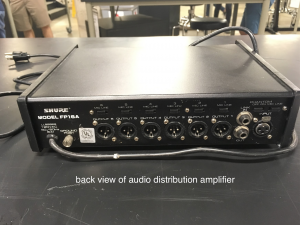

On the outside it didn’t look like much – just a plain black box with a few buttons on the front panel and several outlets for plugging in microphones on the back side. The device was housed in a black metal casing. Each of the sides was bent so that the panels fit together to enclose the inner electronics.
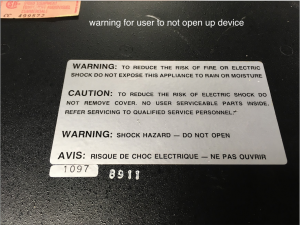 We turned over the box to begin disassembly and discovered a warning label that cautioned against opening it up unless you were a “qualified service personnel” due to shock hazard. This label indicates that this device was probably not meant to be disassembled by a user, but that it was designed to be fixed and serviceable by a professional rather than just thrown out after it breaks. Besides the plugs, dials and buttons, the battery case was the only visible and accessible component on the outside of the box. Everything else could only be accessed by opening up the whole box. Likely, the battery holder was the only think the designers intended for the user to open up and replace.
We turned over the box to begin disassembly and discovered a warning label that cautioned against opening it up unless you were a “qualified service personnel” due to shock hazard. This label indicates that this device was probably not meant to be disassembled by a user, but that it was designed to be fixed and serviceable by a professional rather than just thrown out after it breaks. Besides the plugs, dials and buttons, the battery case was the only visible and accessible component on the outside of the box. Everything else could only be accessed by opening up the whole box. Likely, the battery holder was the only think the designers intended for the user to open up and replace.

The casing was held together by screws on each of the panels. After unscrewing the panels, the circuit boards and motors and wires were exposed! Everything seemed to be assembled with traditional fasteners, solder and clips. We detached all of the wires and separated the components. Most of the leads of the electronic components were soldered directly to the circuit board. Likely, the board itself was not designed to be disassembled or extensively repaired. However, the large components were snapped on or screwed into place and most of their wires were ribbon cables that could be easily attached and detached from the main circuit board, which would have made assembly and replacement relatively easy. This indicates that the larger components were potentially meant to be replaced by a skilled technician.
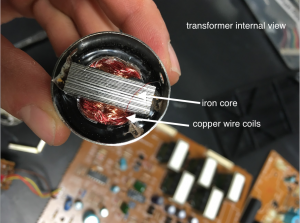
The main circuit board was covered in an array of transformers, each of which were soldered to the board. These transformers consisted of coils of copper wire surrounding by an iron block. The purpose of the transformers was likely to convert AC power to DC power. We initially confused these parts with brushless DC motors due to the appearance of the wound copper wire. But after realizing that motors didn’t belong in audio equipment, I talked to a friend who understood audio equipment and he let me know that they were transformers. Taking them apart required breaking them off of the circuit board. While they could be removed with relative ease, reattaching them would require soldering the leads back onto the board. Additionally, the transformers couldn’t really be taken apart, so if one broke it would have to be replaced instead of repaired.
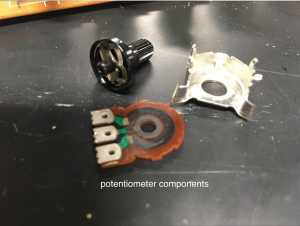
The circuit board also had other electronic components like capacitors, resistors, potentiometers, and a fuse. The potentiometers were each connected to one of the dials on the outside of the box. Likely, the potentiometers were used to add resistance in adjusting the different inputs on the audio control box. We were able to detach the potentiometers and take apart their components. These were very easy to take off, but to take them apart we had to use pliers to bend back the metal casing and clips, which meant we wouldn’t easily be able to reassemble it. The potentiometers could probably be replaced but they probably weren’t manufactured to be repaired.
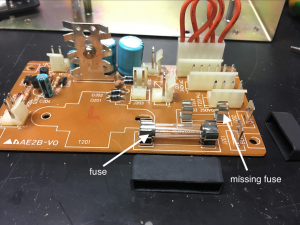
A secondary circuit board connected to the battery holder and held a fuse. One thing that was odd was that there was an identical second fuse holder, but no second fuse. We speculated that this could have been due to a manufacturing error, a repair that removed it, or most likely this was a circuit board part that was configurable to be used in several different devices.
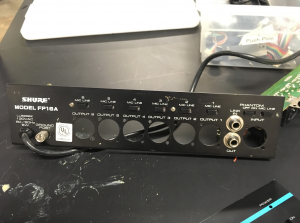
Most of the individual components seemed to be standard, off-the-shelf electronics that weren’t made specially for this device. Even the casing was probably manufactured by some other company and the decals labelling the ports and dials were probably put on to match this specific device.
One thing that was disappointing to see was that while the distribution amplifier device was serviceable, not a lot of the internal components could be fixed – only replaced – and it would take someone skilled to do that. Some parts of the device could be recycled – for example the wires, potentiometers, fuse and transformers – as they could all be detached relatively easily and are standard electronic parts that could be used for other things.
Ultimately, I learned that many devices seem like black boxes that are impossible to understand. The casing obscures the user’s understanding of how the device works, as well as what the device is comprised of. This can be especially problematic in terms of repairing a broken device, and explains why so many products end up in landfill. Many users would likely be scared to try to fix it themselves (especially given the warning label) and completely ignorant that it can even be fixed. However, once you actually open the device up, you are able understand how the various parts work together, and see that parts of it were actually designed to be repairable.
